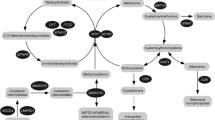Abstract
Background
Newborn screening is a precondition for early diagnosis and successful treatment of remethylation disorders and classical homocystinuria (cystathionine-ß-synthase deficiency). Newborn screening for classical homocystinuria using total homocysteine measurement in dried blood spots has been very successfully performed for many years for newborns from Qatar.
Methods
A new optimized newborn screening strategy for remethylation disorders and homocystinuria was developed and evaluated for newborns from Qatar using total homocysteine measurement as first-tier and methionine, methionine-phenylalanine-ratio and propionylcarnitine as second-tiers. Proposed cut-offs were also retrospectively evaluated in newborn screening samples of 12 patients with remethylation disorders and vitamin B12 deficiency from Qatar and Germany.
Results
Over a 12 months period, the proposed strategy led to a decrease in the recall rate in homocysteine screening for Qatar from 1.09% to 0.68%, while allowing for additional systematic inclusion of remethylation disorders and vitamin B12 deficiency into the screening panel for Qatar. In the evaluated period the applied strategy would have detected all patients with classical homocystinuria identified by the previous strategy and in addition 5 children with maternal nutritional vitamin B12 deficiency and one patient with an isolated remethylation disorder. Additional retrospective evaluation of newborn screening samples of 12 patients from Germany and Qatar with remethlyation disorders or vitamin B12 deficiency showed that all of these patients would have been detected by the cut-offs used in the proposed new strategy. In addition, an adapted strategy for Germany using methionine, methionine-phenylalanine-ratio and propionylcarnitine as first-tier, and homocysteine as a second-tier test was also positively evaluated retrospectively.
Conclusions
The proposed strategy for samples from Qatar allows inclusion of remethylation disorders and vitamin B12 deficiency in the screening panel, while lowering the recall rate. An adapted second-tier strategy is presented for screening in Germany and will be prospectively evaluated over the next years in a pilot project named “Newborn Screening 2020”.
Similar content being viewed by others
References
Huemer M, Kozich V, Rinaldo P, Baumgartner MR, Merinero B, Pasquini E, et al. Newborn screening for homocystinurias and methylation disorders: systematic review and proposed guidelines. J Inherit Metab Dis 2015;38:1007–1019.
Wong D, Tortorelli S, Bishop L, Sellars EA, Schimmenti LA, Gallant N, et al. Outcomes of four patients with homocysteine remethylation disorders detected by newborn screening. Genet Med 2016;18:162–167.
El Bashir H, Dekair L, Mahmoud Y, Ben-Omran T. Neurodevelopmental and cognitive outcomes of classical homocystinuria: experience from Qatar. JIMD Rep 2015;21:89–95.
Whitehead VM. Acquired and inherited disorders of cobalamin and folate in children. Br J Haematol 2006;134:125–136.
Gan-Schreier H, Kebbewar M, Fang-Hoffmann J, Wilrich J, Abdoh G, Ben-Omran T, et al. Newborn population screening for classic homocystinuria by determination of total homocysteine from Guthrie cards. J Pediatr 2010;156:427–432.
Okun JG, Gan-Schreier H, Ben-Omran T, Schmidt KV, Fang-Hoffmann J, Gramer G, et al. Newborn screening for vitamin B6 non-responsive classical homocystinuria-systematical evaluation of a two-tier strategy. JIMD Rep 2016 June 21. [Epub ahead of print]
Schulze A, Lindner M, Kohlmüller D, Olgemöller K, Mayatepek E, Hoffmann GF. Expanded newborn screening for inborn errors of metabolism by electrospray ionization-tandem mass spectrometry: results, outcome, and implications. Pediatrics 2003;111:1399–1406.
McHugh D, Cameron CA, Abdenur JE, Abdulrahman M, Adair O, Al Nuaimi SA, et al. Clinical validation of cutoff target ranges in newborn screening of metabolic disorders by tandem mass spectrometry: a worldwide collaborative project. Genet Med 2011;13:230–254.
Bowron A, Barton A, Scott J, Stansbie D. Blood spot homocysteine: a feasibility and stability study. Clin Chem 2005;51:257–258.
Huemer M, Scholl-Burgi S, Hadaya K, Kern I, Beer R, Seppi K, et al. Three new cases of late-onset cblC defect and review of the literature illustrating when to consider inborn errors of metabolism beyond infancy. Orphanet J Rare Dis 2014;9:161.
Weisfeld-Adams JD, Bender HA, Miley-Akerstedt A, Frempong T, Schrager NL, Patel K, et al. Neurologic and neurodevelopmental phenotypes in young children with earlytreated combined methylmalonic acidemia and homocystinuria, cobalamin C type. Mol Genet Metab 2013;110:241–247.
Fischer S, Huemer M, Baumgartner M, Deodato F, Ballhausen D, Boneh A, et al. Clinical presentation and outcome in a series of 88 patients with the cblC defect. J Inherit Metab Dis 2014;37:831–840.
Diekman EF, de Koning TJ, Verhoeven-Duif NM, Rovers MM, van Hasselt PM. Survival and psychomotor development with early betaine treatment in patients with severe methylenetetrahydrofolate reductase deficiency. JAMA Neurol 2014;71:188–194.
Huemer M, Burer C, Jesina P, Kozich V, Landolt MA, Suormala T, et al. Clinical onset and course, response to treatment and outcome in 24 patients with the cblE or cblG remethylation defect complemented by genetic and in vitro enzyme study data. J Inherit Metab Dis 2015;38:957–967.
Tortorelli S, Turgeon CT, Lim JS, Baumgart S, Day-Salvatore DL, Abdenur J, et al. Two-tier approach to the newborn screening of methylenetetrahydrofolate reductase deficiency and other remethylation disorders with tandem mass spectrometry. J Pediatr 2010;157:271–275.
Malvagia S, Haynes CA, Grisotto L, Ombrone D, Funghini S, Moretti E, et al. Heptadecanoylcarnitine (C17) a novel candidate biomarker for newborn screening of propionic and methylmalonic acidemias. Clin Chim Acta 2015;450:342–348.
Weisfeld-Adams JD, Morrissey MA, Kirmse BM, Salveson BR, Wasserstein MP, McGuire PJ, et al. Newborn screening and early biochemical follow-up in combined methylmalonic aciduria and homocystinuria, cblC type, and utility of methionine as a secondary screening analyte. Mol Genet Metab 2010;99:116–123.
Author information
Authors and Affiliations
Corresponding author
Rights and permissions
About this article
Cite this article
Gramer, G., Abdoh, G., Ben-Omran, T. et al. Newborn screening for remethylation disorders and vitamin B12 deficiency-evaluation of new strategies in cohorts from Qatar and Germany. World J Pediatr 13, 136–143 (2017). https://doi.org/10.1007/s12519-017-0003-z
Received:
Accepted:
Published:
Issue Date:
DOI: https://doi.org/10.1007/s12519-017-0003-z




